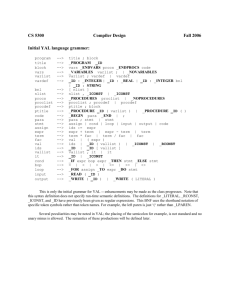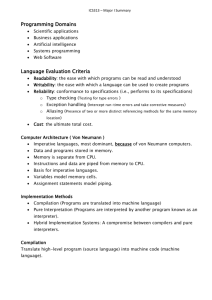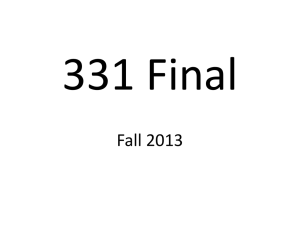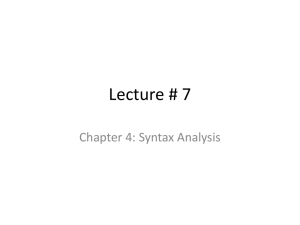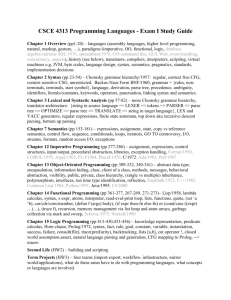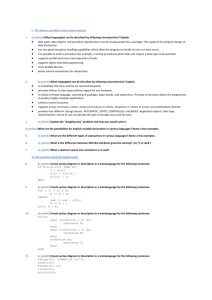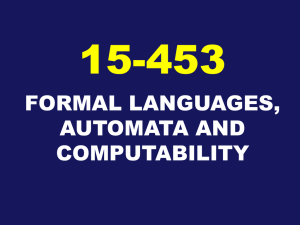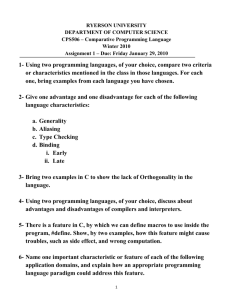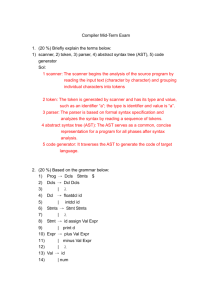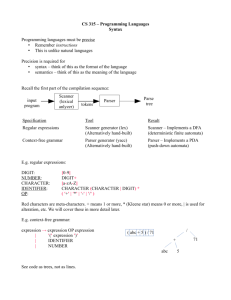Chapter 3 “Describing Syntax and Semantics”
advertisement
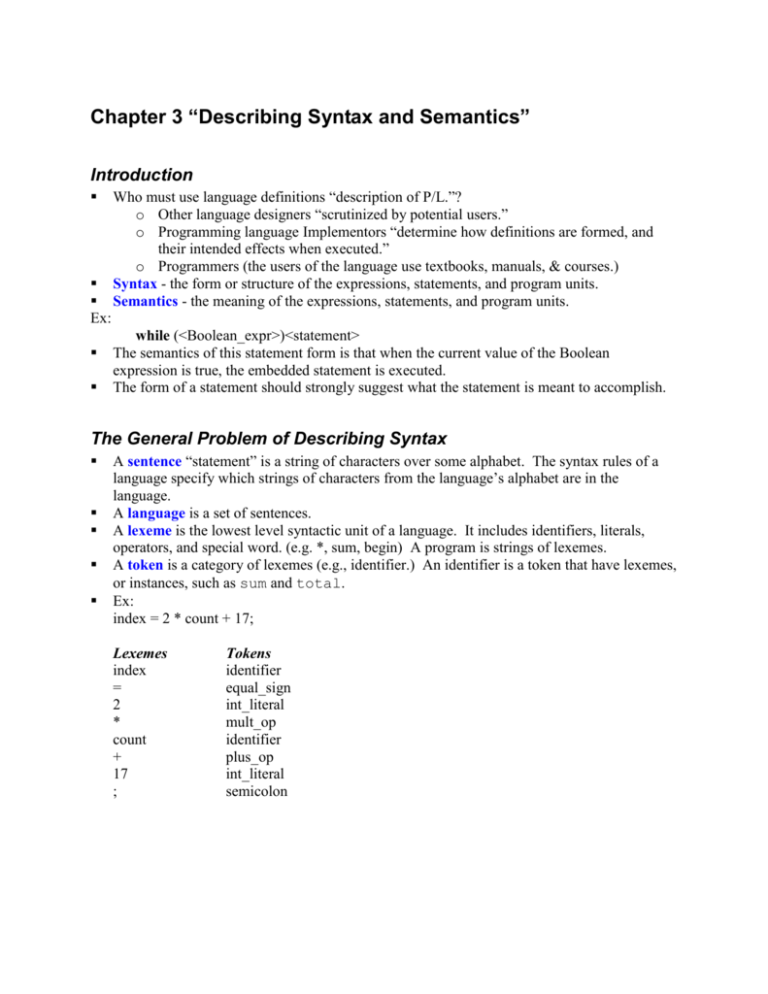
Chapter 3 “Describing Syntax and Semantics”
Introduction
Ex:
Who must use language definitions “description of P/L.”?
o Other language designers “scrutinized by potential users.”
o Programming language Implementors “determine how definitions are formed, and
their intended effects when executed.”
o Programmers (the users of the language use textbooks, manuals, & courses.)
Syntax - the form or structure of the expressions, statements, and program units.
Semantics - the meaning of the expressions, statements, and program units.
while (<Boolean_expr>)<statement>
The semantics of this statement form is that when the current value of the Boolean
expression is true, the embedded statement is executed.
The form of a statement should strongly suggest what the statement is meant to accomplish.
The General Problem of Describing Syntax
A sentence “statement” is a string of characters over some alphabet. The syntax rules of a
language specify which strings of characters from the language’s alphabet are in the
language.
A language is a set of sentences.
A lexeme is the lowest level syntactic unit of a language. It includes identifiers, literals,
operators, and special word. (e.g. *, sum, begin) A program is strings of lexemes.
A token is a category of lexemes (e.g., identifier.) An identifier is a token that have lexemes,
or instances, such as sum and total.
Ex:
index = 2 * count + 17;
Lexemes
index
=
2
*
count
+
17
;
Tokens
identifier
equal_sign
int_literal
mult_op
identifier
plus_op
int_literal
semicolon
Language Recognizers
In general can be formally defined in two distinct ways.
Language Recognizers: used in compilers.
o The syntax analysis part of a compiler is a recognizer for the language the compiler
translates.
o They determine whether given programs are in the language.
Syntax Analyzers: determine whether the given programs are syntactically correct.
Language Generators: generate the sentences of a language.
Formal Methods of Describing Syntax
Backus-Naur Form and Context-Free Grammars
It is a syntax description formalism that became the mostly wide used method for P/L syntax.
Context-free Grammars
– Developed by Noam Chomsky in the mid-1950s who described four classes of generative
devices or grammars that define four classes of languages.
– Context-free and regular grammars are useful for describing the syntax of P/Ls.
– Tokens of P/Ls can be described by regular grammars.
– Whole P/Ls can be described by context-free grammars.
Backus-Naur Form (1959)
– Invented by John Backus to describe ALGOL 58 syntax.
– BNF is equivalent to context-free grammars used for describing syntax.
Fundamentals
– A metalanguage is a language used to describe another language “Ex: BNF.”
– In BNF, abstractions are used to represent classes of syntactic structures--they act like
syntactic variables (also called nonterminal symbols)
<while_stmt> while ( <logic_expr> ) <stmt>
– This is a rule; it describes the structure of a while statement
– A rule has a left-hand side (LHS) “The abstraction being defined” and a right-hand side
(RHS) “consists of some mixture of tokens, lexemes and references to other
abstractions”, and consists of terminal and nonterminal symbols.
– A grammar is a finite nonempty set of rules and the abstractions are called nonterminal
symbols, or simply nonterminals.
– The lexemes and tokens of the rules are called terminal symbols or terminals.
– An abstraction (or nonterminal symbol) can have more than one RHS
<stmt> <single_stmt>
| begin <stmt_list> end
– Multiple definitions can be written as a single rule, with the different definitions
separated by the symbol |, meaning logical OR.
Describing Lists
•
Syntactic lists are described using recursion.
<ident_list> ident
| ident, <ident_list>
•
A rule is recursive if its LHS appears in its RHS.
Grammars and derivations
•
•
•
The sentences of the language are generated through a sequence of applications of the
rules, beginning with a special nonterminal of the grammar called the start symbol.
A derivation is a repeated application of rules, starting with the start symbol and ending
with a sentence (all terminal symbols)
An example grammar:
<program> <stmts>
<stmts> <stmt> | <stmt> ; <stmts>
<stmt> <var> = <expr>
<var> a | b | c | d
<expr> <term> + <term> | <term> - <term>
<term> <var> | const
•
An example derivation:
<program> => <stmts> => <stmt>
=> <var> = <expr> => a = <expr>
=> a = <term> + <term>
=> a = <var> + <term>
=> a = b + <term>
=> a = b + const
•
•
Every string of symbols in the derivation, including <program>, is a sentential form.
A sentence is a sentential form that has only terminal symbols.
•
•
A leftmost derivation is one in which the leftmost nonterminal in each sentential form is
the one that is expanded. The derivation continues until the sentential form contains no
nonterminals.
A derivation may be neither leftmost nor rightmost.
Parse Trees
•
•
Hierarchical structures of the language are called parse trees..
A parse tree for the simple statement A = B + const
<program>>
<stmts>
<stmt>
<var>
a
=
<expr>
<term> +
<term>
<var>
b
const
Ambiguity
•
•
A grammar is ambiguous iff it generates a sentential form that has two or more distinct
parse trees.
Ex: Two distinct parse trees for the same sentence, const – const / const
<expr> <expr> <op> <expr> | const
<op> / | -
•
Ex: Two distinct parse trees for the same sentence, A = B + A * C
<assign>
<id>
<expr>
|
|
|
<id> = <expr>
A|B|C
<expr> + <expr>
<expr> * <expr>
(<expr>)
<id>
Operator Precedence
•
•
•
The fact that an operator in an arithmetic expression is generated lower in the parse tree
can be used to indicate that it has higher precedence over an operator produced higher up
in the tree.
In the left parsed tree above, one can conclude that the * operator has precedence over the
+ operator. How about the tree on the right hand side?
An unambiguous Grammar for Expressions
<assign>
<id>
<expr>
|
<term>
|
<factor>
|
A=B+C*A
<id> = <expr>
A|B|C
<expr> + <term>
<term>
<term> * <factor>
<factor>
(<expr>)
<id>
Associativity of Operators
•
•
Do parse trees for expressions with two or more adjacent occurrences of operators with
equal precedence have those occurrences in proper hierarchical order?
An example of an assignment using the previous grammar is:
A=B+C+A
•
Figure above shows the left + operator lower than the right + operator. This is the correct
order if + operator meant to be left associative, which is typical.
Extended BNF
Because of minor inconveniences in BNF, it has been extended in several ways. EBNF
extensions do not enhance the descriptive powers of BNF; they only increase its readability
and writability.
Optional parts are placed in brackets ([ ])
<proc_call> -> ident [ ( <expr_list>)]
Put alternative parts of RHSs in parentheses and separate them with vertical bars
<term> -> <term> (+ | -) const
Put repetitions (0 or more) in braces ({ })
<ident> -> letter {letter | digit}
BNF:
<expr> <expr> + <term>
| <expr> - <term>
| <term>
<term> <term> * <factor>
| <term> / <factor>
| <factor>
EBNF:
<expr> <term> {(+ | -) <term>}
<term> <factor> {(* | /) <factor>}
Describing the Meanings of Programs: Dynamic Semantics
Axiomatic Semantics
Axiomatic Semantics was defined in conjunction with the development of a method to prove
the correctness of programs.
Such correction proofs, when they can be constructed, show that a program performs the
computation described by its specification.
In a proof, each statement of a program is both preceded and followed by a logical
expression that specified constraints on program variables.
Approach: Define axioms or inference rules for each statement type in the language (to allow
transformations of expressions to other expressions.)
The expressions are called assertions.
Assertions
Axiomatic semantics is based on mathematical logic. The logical expressions are called
predicates, or assertions.
An assertion before a statement (a precondition) states the relationships and constraints
among variables that are true at that point in execution.
An assertion following a statement is a postcondition.
A weakest precondition is the least restrictive precondition that will guarantee the
validity of the associated postcondition.
Pre-post form: {P} statement {Q}
An example: a = b + 1 {a > 1}
One possible precondition: {b > 10}
Weakest precondition:
{b > 0}
If the weakest precondition can be computed from the given postcondition for each
statement of a language, then correctness proofs can be constructed from programs in that
language.
Program proof process: The postcondition for the whole program is the desired result.
Work back through the program to the first statement. If the precondition on the first
statement is the same as the program spec, the program is correct.
An Axiom is a logical statement that is assumed to be true.
An Inference Rule is a method of inferring the truth of one assertion on the basis of the
values of other assertions.
Assignment Statements
Ex:
a=b/2–1
{a < 10}
The weakest precondition is computed by substituting b / 2 -1 in the assertion {a < 10} as
follows:
b/2–1
b/2
b
< 10
< 11
< 22
∴ the weakest precondition for the given assignment and the postcondition is {b < 22}
An assignment statement has a side effect if it changes some variable other than its left
side.
Ex:
x = 2 * y – 3 {x > 25}
2 * y – 3 > 25
2 * y > 28
y > 14
∴ the weakest precondition for the given assignment and the postcondition is {y > 14}
Ex:
x = x + y – 3 {x > 10}
x + y – 3 > 10
y > 13 – x
Sequences
The weakest precondition for a sequence of statements cannot be described by an axiom,
because the precondition depends on the particular kinds of statements in the sequence.
In this case, the precondition can only be described with an inference rule.
Ex:
y = 3 * x + 1;
x = y + 3;
{x < 10}
y + 3 < 10
y<7
3*x+1<7
3*x<6
x<2
Logical Pretest Loops
Computing the weakest precondition (wp) for a while loop is inherently more difficult
than for a sequence b/c the number of iterations can’t always be predetermined.
The corresponding step in the axiomatic semantics of a while loop is finding an assertion
called a loop invariant, which is crucial to finding the weakest precondition.
It is helpful to treat the process of producing the wp as a function, wp.
To find I, we use the loop postcondition to compute preconditions for several different
numbers of iterations of the loop body, starting with none. If the loop body contains a
single assignment statement, the axiom for assignment statements can be used to compute
these cases.
wp(statement, postcondition) = precondition
Ex:
while y <> x do y = y + 1 end
{y = x}
For 0 iterations, the wp is {y = x}
For 1 iteration,
wp(y = y + 1), {y = x}) = {y + 1 = x}, {y = x – 1}
For 2 iterations,
wp(y = y + 1), {y = x - 1}) = {y + 1 = x - 1}, {y = x – 2}
For 3 iterations,
wp(y = y + 1), {y = x - 2}) = {y + 1 = x - 2}, {y = x – 3}
It is now obvious that {y < x} will suffice for cases of one or more iterations. Combining
this with {y = x} for the 0 iterations case, we get {y <= x} which can be used for the loop
invariant.
Ex:
while s > 1 do s = s / 2 end
{s = 1}
For 0 iterations, the wp is {s = 1}
For 1 iteration,
wp(s > 1, {s = s / 2}) = {s / 2 = 1}, {s = 2}
For 2 iterations,
wp(s > 1, {s = s / 2}) = {s / 2 = 2}, {s = 4}
For 3 iterations,
wp(s > 1, {s = s / 2}) = {s / 2 = 4}, {s = 8}
s is a nonnegative power of 2.
The loop invariant I is a weakened version of the loop postcondition, and it is also a
precondition.
I must be weak enough to be satisfied prior to the beginning of the loop, but when
combined with the loop exit condition, it must be strong enough to force the truth of
the postcondition.
